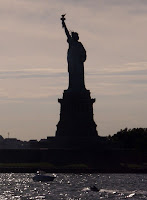 |
| wespokejewish.com/ |
As much as I love deciphering meaning, I find I also like sowing it, and have had an opportunity to do so in the book I am publishing, creating layers of meaning like little surprise packages. I do that often in my paintings, hiding a deeper story in image. When I share the story, it often pulls people in, a shared secret that deepens the meaning.
So let me share a few layers of meaning from within the book.
The name of the book is We Spoke Jewish: A Legacy in Stories. It explores the stories and experiences of those who grew up in early Jewish communities, survivors who came to the US in the 1940s and 1950s, and immigrants from the former Soviet Union who came in the 1970s-1990s. So what does that title mean? One of the people I interviewed spoke of speaking Jewish, meaning Yiddish. "There was no such thing as not speaking Jewish," she said as she described the early Jewish community of the North Side. I was used to the term Yiddish to represent the language, but many of those I interviewed used the words Jewish and Yiddish interchangeably. And it wasn't just for language, but also identity. You could be Yiddish and speak Jewish. The phrasing surprised me, inverted from what I expected.
But not everyone spoke Jewish in the sense of Yiddish. Certainly survivors I interviewed from Germany did not. Some of the immigrants from the former Soviet Union had vague memories of a grandparent speaking Yiddish. Was there perhaps another meaning for "speaking Jewish?" Could I expand it metaphorically?
When I thought of survivors of the Holocaust, it occurred to me that they had a unique role in the larger community, that of memory. They carried deep within them the memory of lost family and of a lost world, a world in which many of us had ancestral roots. A close friend of mine who is a survivor often speaks of her ten cousins who did not survive. Her commitment to sharing her memory is in part on their behalf. Each of the survivors spoke the Jewish of memory.
The immigrants from the former Soviet Union spoke a different kind of Jewish, the Jewish of culture. Unable to practice their religion, they shared their heritage through culture. They sang songs they had learned as children, spoke of recipes passed down by their mothers and told stories of the holidays once celebrated.
These three groups spoke the Jewish of language, memory and culture, all ways that identity is formed, expressed and passed on. The title began to carry a certain resonance, initially an inversion of Yiddish and Jewish that startled me, and a new and broader meaning ascribed to the term to encompass all of those whom I interviewed.
 More layers of meaning are hidden in elements of the design. The designer wanted a form to repeat in each section. The original form that she selected was composed of curved shapes, but not with any specific meaning. I decided I wanted something that would hold meaning in its folds, but what? I began by exploring the meaning behind different Hebrew letters and settled on the aleph, the first letter of the Hebrew alphabet. I remembered something I had learned in the Jewish Artists' Lab, of how Rabbi Naftali Horowitz looked to the letter aleph which represents the name of God and noted that it echoes the form of our face. If we disassemble it we see two yuds and a vav, two eyes and a nose, figuratively holding God before us in our own face and perhaps in that of another person.
More layers of meaning are hidden in elements of the design. The designer wanted a form to repeat in each section. The original form that she selected was composed of curved shapes, but not with any specific meaning. I decided I wanted something that would hold meaning in its folds, but what? I began by exploring the meaning behind different Hebrew letters and settled on the aleph, the first letter of the Hebrew alphabet. I remembered something I had learned in the Jewish Artists' Lab, of how Rabbi Naftali Horowitz looked to the letter aleph which represents the name of God and noted that it echoes the form of our face. If we disassemble it we see two yuds and a vav, two eyes and a nose, figuratively holding God before us in our own face and perhaps in that of another person.
I believe it is through story that we form powerful connections with each other. When we truly look at another person, when we hear their story, we see ourselves and perhaps a little piece of that which connects each of us. To really see another person and to listen deeply to their story is what this book is about. It is also an exploration of identity. As I interviewed each person, I found elements of myself and of our shared humanity. What could possibly capture that better than an aleph?
The stories themselves also offer surprises, little bits of knowledge that deepened my awareness in unanticipated ways. Within the paintings are still more layers of meaning, often the result of some free association as I considered the stories of my interviewees and how to share them. Free association, metaphors told with both word and image, hidden elements that inform and surprise, layered meaning -- all are elements that enrich storytelling and form important aspects of my book.
Read more about the book at wespokejewish.com.
Read more about the book at wespokejewish.com.






